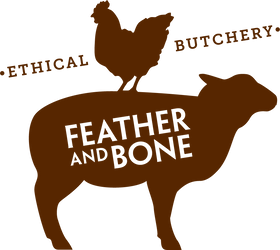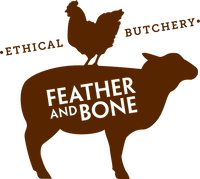What do pasture-raised pigs eat?
We are what our food eats, so what do pigs eat?
Recently a customer expressed interest in buying our pork lard but first wanted to know what the pigs we source are fed. ‘Can you tell me exactly what they're eating and in what ratio? For example - are they fed soy / corn and at what percentage compared to vegetables / fruit / meat etc.’
It’s been a while since we compared notes about pigs' diets so we dutifully sent out a request for information so we could report back to the customer. As always, the farmers' responses were swift, generous and comprehensive with lots of interesting information. As always, the farmers' responses were swift, generous and comprehensive with lots of interesting information - omnivorous pigs eat everything from grains, grasses and grubs to feta and whey and some go berserk for orange peel.
As we digested the responses, it occurred to us that Mr Pork Lard might not be the only curious customer lurking out there, wondering what the pigs they eat are eating.
So, if you're one of these curious lurkers, you can satisfy your curiosity and lurk no longer because we've collected all the pig menus from the regeneratively-managed, NSW farms with which we work.
Free to roam and feed on pasture
All the farms we source from run their pigs outside for their entire lives. Sows are free to farrow (birth) where and when they wish. Depending on the season, the location, breed and the individual pig's inclination, sows will build nests in the paddock or inside shelters, either from materials provided by the farmer or locally foraged or perhaps a combination of both. Sometimes, if the weather is likely to be very cold or wild and it's the sow's first litter, the farmer may confine her to a penned area in the paddock so that she and her babies can be watched more closely during and after farrowing. Often farmers will separate farrowing sows for calm and safety but, after a few weeks, sows and their litters will usually share paddocks until it’s time for the growers to be weaned.
Weaned growers are then moved into their own paddocks to hang out together until they get a little older at which point some producers may choose to separate the herd into male and female cohorts to slow down the sexual maturation process – boar ‘taint’ being very unappealing to the Australian palate. When the growers have reached an acceptable market size, the best females may be kept for the breeding herd and the rest are carefully dispatched to the abattoir.
Like chickens and humans, pigs are omnivores so they need to be offered a diverse mix of proteins, minerals and nutrients to choose from to ensure they grow and thrive. Throughout their lives, whether they stay on the farm as breeders or end up on your plate, these pasture-raised pigs have a varied diet anchored around a customised pig feed ration augmented with all sorts of products including seasonal grains, fruits, vegetables, excess dairy whey and milk, spent brewers’ grains, excess bakery sourdough and the various grasses, plants, dirt and insects that they dig up in the paddocks. Given the opportunity, pigs actually eat a lot of grass.
While all the farms we work with are connected by a common, regenerative management approach that prioritises ecosystem health and balance, each farm is unique. So, it stands to reason that each farmer’s pig nutrition programme is also unique and constantly evolving in response to the breed, personality, landscape and season.
Common to all of these producers is the reliance on wheat and barley as the major ingredient in all their formulated diet rations and the notable lack of any pharmaceutical inputs. What sets a couple apart is the use of meat and/or blood meal, with varying quantities of other inputs.
Here are the farmers’ responses in alphabetical farm order (for no reason other than I’m a bit OCD).
Photo: Extraordinary Pork pigs by Alan Benson.
Bundarra Berkshires - Barham, NSW
Our pig diet consists of a pellet of NON GM comprised of barley, wheat, peas, lupins and a mineral mix of beetroot extracts, probiotics, oregano, cinnamon, apple cider vinegar and vegetable oil.
The pigs graze on saltbush, native grasses and pasture, although at this time of the year (high summer), it's dry grass and pellets only. Whenever it's available, we add waste excess produce from local farmers - right now, it's some avocado waste and orange peel, which they go beserk for.
We chose a vegetarian diet because while the pigs grow slower without using meat meals, we believe it is better for their gut heath and overall meat texture, sweetness and a clean earthy finish.
Extraordinary Pork - Eumungerie, NSW
We feed our pigs a custom-made pellet designed by a nutritionist that is wheat and barley based and carefully calibrated to produce a balanced diet of protein, energy and fat. If the balance is out we end up with fat pigs or poor muscle development or both!!
The ingredients are GMO free and there is no meat meal or blood meal. Currently, the diet includes these key elements: wheat 50%, barley 12%, soy bean meal 12%, canola meal 8%.
There are also some other ingredients including salt, lime, a nutrient premix and some amino acids (they are derived from plants and ensure good muscle development). We don’t supplement them with any food scraps but they certainly make good use of grass, bugs and grubs out in the paddock.
Near River - Hollisdale, NSW
In addition to the grasses and bugs foraged in the paddocks, the sows, weaners and grower pigs are fed a primary wheat feed, a barley mix and some additional, locally-sourced excess farm waste. The pigs are offered differing ratios depending on when they require higher protein rates. No corn, though some soymeal.
Primarily we feed our pigs wheat that we mill on farm. We are very pleased to be able to source wheat from NSW again after shipping it from WA for the last year or so. We do our best to source chemical-free wheat.
We mix this with a proprietary ‘concentrate’ from Riverina Stockfeeds. The base raw materials may change seasonally but the typical composition includes soybean meal, cottonseed meal, canola meal, pulses, meat and blood meal, amino acids, salt, dicalcium phosphate, mould inhibitor, Riverina vitamin & mineral premix. In the last six weeks we have also added a biscuit meal to these mixes, to increase the energy component. This is created from out of date or incorrectly packaged biscuit goods.
These components comprise the prepared ration that is 62% of the daily grower diet and are mixed in the following ratios: wheat 60%, concentrate 20%, biscuit meal 20%.
The remaining 38% of the pigs’ daily diet is comprised of barley, in the form of spent brewer’s grain from one of our local craft brewers. In addition, each day the pigs also get around 600 litres of whey from our local cheese factory, Real Dairy. Research suggests that whey consumption can replace up to 30% of a regular grain diet, and we have found that as our heritage breeds (Berkshire and Wessex Saddlebacks) are prone to high fat scores, the addition of whey diminishes this.
We also source fruit and vegetable ‘waste’ from a local food processor, usually 2-300 kgs each week, mostly tomatoes and strawberries. There is also irregular sourdough waste from our baker, and out of date lines from the dairy, usually cream or feta.
Oxhill Organics - Wauchope, NSW
Each pig gets approximately 1.5 kg grain, 0.5 litres milk and as much grass as they want to eat! The pigs wander on certified organic pastures, so the 'grass' includes rye, oats, chicory, clover, paspalum, kikuyu, plantain and the composition changes depending on the season.
Every morning, the pigs get a feed of dry grain comprised of organic barley 71% (Mara Seeds), organic wheat 20% (Mara Seeds), soybean meal 6% (Mara Seeds), organic minerals 3% (Ag Solutions) and biochar (Mara Seeds) to which we add 20 litres of organic raw milk from our dairy.
Pillar Rock Pork - Binaway, NSW
I feed my pigs a pellet which I find suits my sows and young pigs. The sows get a lower protein feed than the young stock. I have been using the same feed mill - Premier Stockfeeds - since 2016 and the product is consistent in quality, my pigs do well on it and they are good to deal with. I don't give them anything else and do not change it around.
The pellet ingredients include barley, wheat, sorghum, meatmeal, sunflower meal, tallow, methionine, lysine, salt, vitamins and trace minerals.
With all the recent rain, the native grasses are bouncing away so the pigs are enjoying grazing the pasture.
Saulsbury Berkshires - Frogmore, NSW
We feed our pigs a soybean protein-based pellet - not meat meal. We choose to feed a pellet ratio that is specially tailored to meet the pigs nutritional needs, rather than mixing our own.
In addition the pigs receive a variety of the seasonal produce that we grow here on the farm. Depending on the season, this includes vegetables, fruits, nuts and specifically grown crops including rye grass and Saccaline, a heritage strain of sorghum.
Periodically, the pigs also receive a special treat of fresh jersey milk, corn and pollard/bran mash. This mash is used to introduce young piglets to an adult diet and also as an animal husbandry technique to help with moving and the weighing of pigs.
Spring Grove
Our pigs get approx 900g of pelletised feed per day from the Riverina feed mill here in Casino.
Typical composition includes wheat, sorghum, barley, maize, bran and pollard, vegetable protein meals, pulses, meat and blood meal, salt, molasses, vegetable oil, amino acids, lime, dicalcium phosphate, mould inhibitor, Riverina vitamin and mineral premix. Base raw materials may gradually change seasonally.
All the rest comes from the pasture they graze.
Tathra Place - Wombeyan Caves, NSW
We feed our pigs a Vella ration that is chemical, pharmaceutical and GMO free. Ingredients and ratios are subject to change based on availability and season. No crude protein in any form. Up to 30% of the pigs' diet is perennial pasture, legumes, as well as bugs grubs, tree sap….anything they can find!
Raw ingredients of the granular feed prepared by Vella Stock Food.
1013 Wheat (+Enzyme)
1200 Barley (+ ENZ)
2487 Vegetable oil
2580 Canola Meal (Coota)
2627 Soybean meal
2753 Millrun
3179 Limestone (fine)
3207 Dicalcium Phosphate
3208 Mono Dicalcium Phosphate
3225 Salt
3233 Choline Chloride 60%
3275 Lysine HCL
4539 S_500Gr/T_Phytase TPT 1000
4546 Axtra XB 201 TPT
4970 HP Pig Grower
Wallendbeen Park - Wallendbeen, NSW
The pigs are fed twice a day and receive about 2.5 kg per adult pig per day - dispersed on the ground, not in feeders. The growers are given the same feed prior to weaning. No meat products or swill in the diet.
We don't wean our pigs so we can fully utilise the sow's milk, which takes about 100 days. This means that the piglets/growers stay up to 120 days or longer with the sow before they're separated. During that time, we gradually train the grower pigs by feeding them separately in the yards while the sows get a bigger ration outside the yards. After four months, the separation process is easy and stress-free.
Apart from foraged food, the daily diet consists of about 40% cracked corn (soaked) and 50% commercial pellets comprised of cereal gains and products (barley, wheat, bran and pollard), canola meal, lupins, limestone, bentonite, salt, Acid Buf®, mineral and vitamin premix, enzymes, essential Amino Acids.
The remaining 10% comes from paddock plants and grasses, plants, worms, insects etc. – whatever they dig up and forage in the paddock.
Also excess seasonal fruits such as apples, cherries, peaches - when available.





LOVE the pork report – ‘What do pasture-raised pigs eat?’ as I’ve wondered this myself, and fantastic news on the nitrate-free bacon! Keep up the good work, it’s very much appreciated :)
Leave a comment